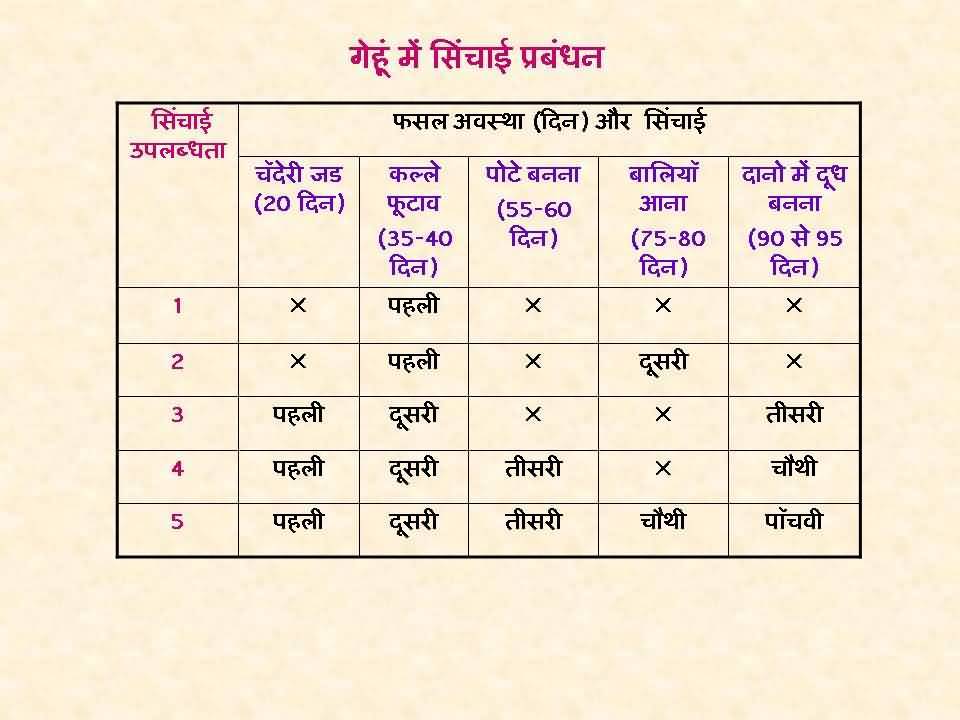भारत मे गेंहू उगाने की तकनीक
India is the fourth largest producer of wheat in the world. Wheat is an important cereal crop grown in India. Wheat is cultivated in almost all parts of India. Geographically India has been divided into six wheat growing zones. Wheat is a rabi crop which is sown in the beginning of winter (November-December) and is harvested in the beginning of summer.
Sowing of wheat:
Optimum date of sowing depends on type of variety, weather, soil, irrigation facility etc. However, most appropriate time of sowing is when the daily ambient temperature drops to 20-22 0C. Therefore second fortnight of November is optimum time of sowing in Northern plains
Last Dates up to which sowing would be economical are:
upto 25th December - in North-West plain Zone
upto 10th December - in North-East plain & Central Zone
upto 30th November - in Peninsular Zone
Soaking seeds in water overnight before sowing, using higher seed rate, closer spacing, shallow sowing (2-3 cm) and spreading thin covering of FYM soon after sowing, can reduce loss caused by late sowing,
The dwarf wheats should be sown only at 5-6 cm depth as they have shorter coleoptiles. Seeding depth of 8-10 cm results in poor germination and reduced yield.
The optimum seed rate, for timely sown wheat, is 100 to 125 kg of seed per hectare. Row to row spacing should be 22.5 to 23 cm.
The late sown wheat should be sown in rows spaced 15-18 cm with seed rate 125 to 156 kg/ha (about 25% higher than that of timely sown)
Relay copping of wheat in an early planted potato crop is a high bonus cropping system.
Four to Five rows of wheat grown in two rows of sugarcane is a popular inrercrop practice now a days.
Succeeding wheat crops or wheat grown after rice encounters a number of problems and should be avoided.
Water management in wheat:
The most appropriate criterion of irrigation in wheat crop is physiological or growth stages. These are
चंदेरी जड अवस्था - Crown Root Initiation (21 days after sowing)
कल्ले फूटाव की अवस्था - Late Tillering (42 days after sowing)
पोटे आने की अवस्था - Late Joinging(60 days after sowing)
बालियॉ आने की अवस्था - Flowering (80 days after sowing)
दानो में दूध बनने की अवस्था - Milk stage (95 days after sowing) and
पकने की अवस्था - Dough Ripe (115 days after sowing)
Among these stages, crown root initiation stage is most critical. An irrigation delay of 2 to 3 weeks in this stage reduce the yield by 5 to 10 q/ha.
If level of groundwater is well below root zone (about 100 cm) and significant rainfall is not received during growing season than 4 to 6 irrigations are considered optimum as demanded by soil type, local climate and variety type.
The border method of irrigation is most suitable for wheat crop as it ensures uniform distribution and high water application efficiency.

Nutrients management in wheat
गेहूं की फसल में पोषक तत्वों का प्रबंधन।:
NITROGEN (नत्रजन):
On an exhausted mineral soil, dwarf wheat and tall wheat shows appreciable response upto 120 and 60 kg N per hectare respectively, irrespective of soil type and agro-climatic zone.
Nitrogen applied in 2 split dose, half at sowing and half at first irrigation (Crown Root Initiation Stage) is very efficient and convenient under alll situtions. Recent study reveals that N application 1/3rd at sowing and 2/3 at first node stage gives maximum production.
PHOSPHORUS (फासफोरस):
In wheat crop phosphorus imarts a great influence on growth and development. Application of 40-60 kg P2O5 per hectare is recommended at the time of sowing, depending on the initial soil value.
POTASH AND ZINC (पोटास तथा जिंक):
Most of the soils in India are rich in potash content and quantity of zinc required by wheat is very small. Therefore application of potash and zinc is recommended only if soil tests reveal K and Zn deficency. Under such situation potash at the rate of 40-60 kg K2O per hectare and zinc sulphate at the rate of 25-35 kg per hectare is suggested. Both these nutrients should be placed at the time of sowing.

